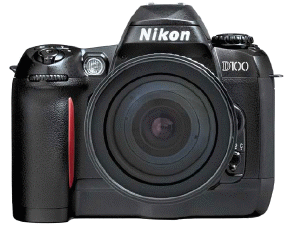 A digital SLR (D-SLR) is a true Single Lens Reflex (SLR) camera with changeable
autofocus lenses. It has an electronically controlled mechanical shutter, and an eyepiece through the lens reflex mirror just like a 35MM film camera. Photographers already used to film cameras will find that true D-SLR's operate the same as with film. For all intents and purposes, you can think of a D-SLR as a professional 35mm camera with a high quality sensor where the film used to be.
A digital SLR (D-SLR) is a true Single Lens Reflex (SLR) camera with changeable
autofocus lenses. It has an electronically controlled mechanical shutter, and an eyepiece through the lens reflex mirror just like a 35MM film camera. Photographers already used to film cameras will find that true D-SLR's operate the same as with film. For all intents and purposes, you can think of a D-SLR as a professional 35mm camera with a high quality sensor where the film used to be.
On the other hand, a point and shoot is just that. You point it and press
the shutter release, and the camera does everything else. It is a nifty
little gadget with a live video display on the back. It fits in your pocket
and you get good snapshots, but you are constrained to the limits of the
camera. With practice and a few workarounds, you reach a point where you
get what you get, and there is just no way to adjust the camera to get
any better. If you want better than snapshots, then it's time for an upgrade
to a D-SLR.
When upgrading to a D-SLR, the first thing point-and-shoot users need to
understand is that there can't be a live digital LCD preview like a point-and-shoot
camera, because the reflex mirror and shutter are in the way of the sensor.
However, you can frame the shot and focus optically through the lens (TTL),
then review the image and exposure histogram on the LCD display at any
time AFTER you take it. You can then decide to keep it or delete it and
take over. It sure saves on film by allowing you to confirm your exposure
on the fly.
The second thing point-and-shoot users need to understand is that an SLR
is not a point-and -shoot. To get really great results with any kind of
SLR, film or digital, you have to tell the camera what to do or tweak the
settings a lot more depending on shooting conditions. You also have to
lug around all of the accessories. You have to learn photography. This
is a lot more work than people new to SLR's expect, but there are fewer
constraints. Many advanced techniques become available with a D-SLR that
are not possible with a point and shoot camera. You get great images, more
photo opportunities, and you can always do more and get better results
with more practice or new accessories.
| SiteMap |

Indy's Camera Review - Digital SLR's
Introduction
©2009 James Melatis - webmaster@indigotide.com

Nikon®,and D100TM
are registered trademarks of the Nikon Corporation.